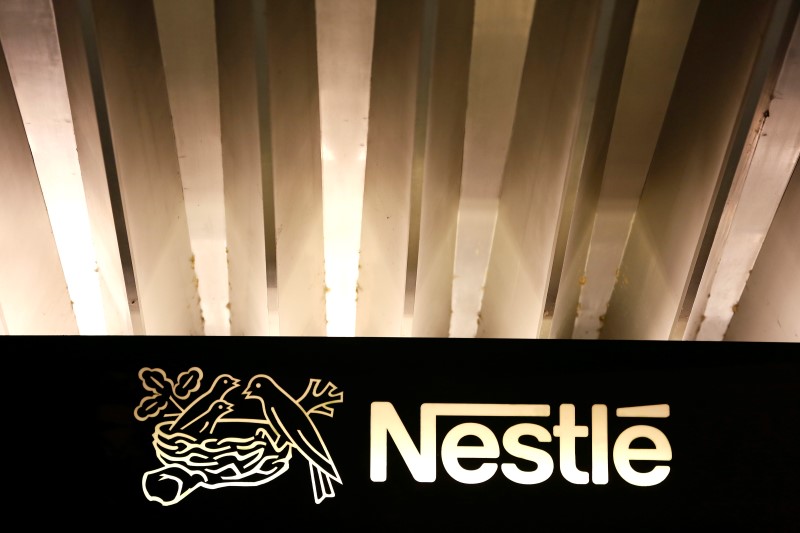Investing.com -- Analysts from Morgan Stanley in a note dated Monday downgraded its outlook on Nestlé to “underweight” from “equal-weight”, lowering its price target to CHF 84 from CHF 91.
This downgrade reflects a more cautious view of Nestlé's near-term prospects and presents several challenges the company faces as it seeks to balance reinvestment in marketing and R&D with the financial pressures of rising commodity costs.
One of the primary reasons Morgan Stanley downgraded Nestlé stems from the company's shift in strategy toward reinvestment.
Over the past several years, the consumer goods giant’s margin growth has largely been driven by aggressive cost-cutting, particularly in advertising and fixed expenses.
While this approach helped boost profits, it came at the expense of market share and brand strength.
As competition intensifies and market share stagnates, Nestlé has little choice but to reinvest heavily in advertising, promotion, and R&D to regain its footing.
“On our estimates, if consumer facing marketing spend (as opposed to agency fees, and production costs) representing around 80% of total advertising & marketing (as opposed to trade spend, which is separately booked in the P&L), is restored to historical (2016) levels, that would imply an additional 170bps in operating cost,” the analysts said
Such a big increase in operational costs puts pressure on profitability, which is compounded by rising commodity prices.
The costs of key inputs, particularly coffee and chocolate, are expected to increase in 2025, making it harder for Nestlé to maintain its current gross margins.
Unlike in previous years, when Nestlé could rely on operational efficiencies to offset cost increases, there are now fewer opportunities to make such savings.
The downgrade also reflects concerns about Nestlé’s organic sales growth, which is now forecasted to be lower than initially expected.
For FY24, Morgan Stanley projects OSG to come in at 2.9%, slightly below the company’s guidance of "at least 3%."
The forecast for FY25 has also been reduced to 3.8%, down from 4.1%, although the analysts expect some recovery by FY26, with OSG reaching 4.5%.
Despite this potential rebound, the near-term outlook paints a challenging picture, with Nestlé likely to lag behind its peers in terms of both growth and profitability.
Morgan Stanley’s concerns also extend to the company’s valuation. At its current market price, Nestlé trades at a 9% premium compared to the broader consumer staples sector, with a price-to-earnings (P/E) ratio of 18.8x for FY25.
This premium assumes superior growth and margin performance, both of which are now in doubt. Given the weaker earnings outlook and increased operational costs, the analysts argue that Nestlé’s valuation is no longer justified.
The financial outlook for Nestlé reflects the challenges ahead. Morgan Stanley projects that Nestlé’s earnings per share (EPS) for FY25 will be 9% below the consensus forecast, with an estimated EPS of CHF 4.69, compared to CHF 5.03.
The gap widens further for FY26, where EPS is forecasted to be 11% below expectations.
Operating margins are expected to decline as a result of the increased marketing and R&D expenditures. Morgan Stanley estimates that the operating profit margin will fall by 57 basis points in FY25 and remain flat in FY26 as the company adjusts to higher costs.
The analysts note that while these investments in marketing and R&D are necessary to support long-term growth, they will weigh heavily on near-term profitability.
Nestlé’s free cash flow yield currently stands at 3.9%, which is below the sector average. Morgan Stanley anticipates that the company’s leverage will remain high, with a debt-to-EBITDA ratio of over 2.5x, limiting Nestlé’s flexibility to engage in share buybacks or pursue large acquisitions.
This restricted financial flexibility further dampens the company’s outlook, particularly when compared to peers such as Danone and Glanbia, which are seen as having stronger balance sheets and better growth prospects.
Incoming CEO Laurent Freixe has outlined plans to refocus on the company’s core strengths in fast-moving consumer goods (FMCG), particularly through increased investment in marketing and product innovation.
However, this strategy carries execution risks, especially given the current state of Nestlé’s balance sheet. High leverage and the lack of flexibility to engage in major restructuring limit the company’s ability to navigate market pressures without compromising profitability.
Commodity prices also pose a substantial risk to Nestlé’s future performance.
With the cost of key inputs such as coffee and chocolate expected to rise, the company will need to manage these increases carefully while avoiding price hikes that could alienate consumers.
Nestlé’s ability to pass on these costs without eroding market share is a critical concern, particularly in its key markets of North America and Europe.
Additionally, Nestlé’s portfolio remains highly diversified, with operations spanning multiple geographies and categories.
While the company has already divested non-core assets such as its U.S. ice cream business and Nestlé Skin Health, further portfolio rationalization could be limited.
Any additional disposals could leave Nestlé with stranded fixed costs, which would further dilute earnings.
Shares of Nestlé traded 0.6% lower on Monday.
